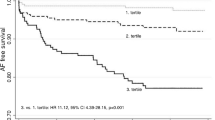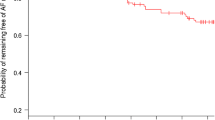Abstract
Background
Recent studies have reported an association between N-terminal atrial natriuretic peptide (NT-proANP) and the progression of atrial fibrillation (AF). However, NT-proANP levels in peripheral and cardiac circulation in AF patients and in non-AF individuals need to be defined. The aims of the current study are (1) to analyze NT-proANP levels in peripheral and cardiac circulation in AF patients and (2) to compare NT-proANP levels in individuals with and without AF.
Methods
We recruited AF patients who were undergoing their first AF catheter ablation and non-AF individuals. Blood plasma samples taken from the femoral vein and the left atrium (LA) were collected before AF ablation in the AF patients and from the cubital vein in the non-AF controls. Low voltage areas (LVAs) were determined using high-density maps during catheter ablation and defined as < 0.5 mV.
Results
The study included 189 AF patients (64 ± 10 years, 59% male, 61% persistent AF, 30% LVAs) and 26 non-AF individuals (58 ± 10 years, 50% male). Patients with AF were significantly older and had larger LA (p < 0.05). Compared to non-AF controls, peripheral and cardiac NT-proANP levels were significantly higher in AF patients without and with LVAs (median 5.4, 10.5, 14.8 ng/ml, respectively, p < 0.001). In multivariable analysis, NT-proANP (OR 1.238, 95% CI 1.007–1.521, p = 0.043) remained significantly different between non-AF individuals and AF patients. In AF, NT-proANP levels were significantly higher in the cardiac blood samples than in the peripheral blood (median 13.0 versus 11.4 ng/ml, p = 0.003). The ability to predict LVAs was modest when using cardiac NT-proANP (AUC 0.661) and peripheral NT-proANP (AUC 0.635), without statistical difference (p = 0.937).
Conclusions
NT-proANP levels are higher in individuals with AF than in controls and are more pronounced in progressed AF. Elevated cardiac and peripheral NT-proANP levels similarly predict LVAs.


Similar content being viewed by others
References
Virani SS, Alonso A, Benjamin EJ, Bittencourt MS, Callaway CW, Carson AP, et al. Heart disease and stroke statistics—2020 update: a report from the American Heart Association. Circulation. 2020;141(9):e139–596. https://doi.org/10.1161/CIR.0000000000000757.
Dilaveris P, Antoniou C-K, Manolakou P, Tsiamis E, Gatzoulis K, Tousoulis D. Biomarkers associated with atrial fibrosis and remodeling. Curr Med Chem. 2019;26(5):780–802. https://doi.org/10.2174/0929867324666170918122502.
Hindricks G, Potpara T, Dagres N, Arbelo E, Bax JJ, Blomström-Lundqvist C, et al. 2020 ESC Guidelines for the diagnosis and management of atrial fibrillation developed in collaboration with the European Association for Cardio-Thoracic Surgery (EACTS). Eur Heart J. 2020;42(5):373–498. https://doi.org/10.1093/eurheartj/ehaa612.
Knecht S, Pradella M, Reichlin T, Mühl A, Bossard M, Stieltjes B, et al. Left atrial anatomy, atrial fibrillation burden, and P-wave duration-relationships and predictors for single-procedure success after pulmonary vein isolation. Europace. 2018;20(2):271–8. https://doi.org/10.1093/europace/euw376.
Njoku A, Kannabhiran M, Arora R, Reddy P, Gopinathannair R, Lakkireddy D, Dominic P. Left atrial volume predicts atrial fibrillation recurrence after radiofrequency ablation: a meta-analysis. Europace. 2018;20(1):33–42. https://doi.org/10.1093/europace/eux013.
Rolf S, Kircher S, Arya A, Eitel C, Sommer P, Richter S, et al. Tailored atrial substrate modification based on low-voltage areas in catheter ablation of atrial fibrillation. Circ Arrhythm Electrophysiol. 2014;7(5):825–33. https://doi.org/10.1161/CIRCEP.113.001251.
Hijazi Z, Oldgren J, Siegbahn A, Granger CB, Wallentin L. Biomarkers in atrial fibrillation: a clinical review. Eur Heart J. 2013;34(20):1475–80. https://doi.org/10.1093/eurheartj/eht024.
Büttner P, Schumacher K, Dinov B, Zeynalova S, Sommer P, Bollmann A, et al. Role of NT-proANP and NT-proBNP in patients with atrial fibrillation: association with atrial fibrillation progression phenotypes. Heart Rhythm. 2018;15(8):1132–7. https://doi.org/10.1016/j.hrthm.2018.03.021.
Seewöster T, Büttner P, Nedios S, Sommer P, Dagres N, Schumacher K, et al. Association between cardiovascular magnetic resonance-derived left atrial dimensions, electroanatomical substrate and NT-proANP levels in atrial fibrillation. J Am Heart Assoc. 2018;7(19): e009427. https://doi.org/10.1161/JAHA.118.009427.
DeLong ER, DeLong DM, Clarke-Pearson DL. Comparing the areas under two or more correlated receiver operating characteristic curves: a nonparametric approach. Biometrics. 1988;44(3):837–45.
Dinov B, Kosiuk J, Kircher S, Bollmann A, Acou W-J, Arya A, et al. Impact of metabolic syndrome on left atrial electroanatomical remodeling and outcomes after radiofrequency ablation of nonvalvular atrial fibrillation. Circ Arrhythm Electrophysiol. 2014;7(3):483–9. https://doi.org/10.1161/CIRCEP.113.001185.
Han FT, Marrouche N. An atrial fibrosis-based approach for atrial fibrillation ablation. Future Cardiol. 2015;11(6):673–81. https://doi.org/10.2217/fca.15.65.
Potter LR, Yoder AR, Flora DR, Antos LK, Dickey DM. Natriuretic peptides: their structures, receptors, physiologic functions and therapeutic applications. Handb Exp Pharmacol. 2009;191:341–66. https://doi.org/10.1007/978-3-540-68964-5_15.
Triposkiadis F, Pieske B, Butler J, Parissis J, Giamouzis G, Skoularigis J, et al. Global left atrial failure in heart failure. Eur J Heart Fail. 2016;18(11):1307–20. https://doi.org/10.1002/ejhf.645.
De Jong AM, Maass AH, Oberdorf-Maass SU, Van Veldhuisen DJ, Van Gilst WH, Van Gelder IC. Mechanisms of atrial structural changes caused by stretch occurring before and during early atrial fibrillation. Cardiovasc Res. 2011;89(4):754–65. https://doi.org/10.1093/cvr/cvq357.
Potter LR. Natriuretic peptide metabolism, clearance and degradation. FEBS J. 2011;278(11):1808–17. https://doi.org/10.1111/j.1742-4658.2011.08082.x.
Seewöster T, Büttner P, Zeynalova S, Hindricks G, Kornej J. Are the atrial natriuretic peptides a missing link predicting low-voltage areas in atrial fibrillation? Introducing the novel biomarker-based atrial fibrillation substrate prediction (ANP) score. Clin Cardiol. 2020;43(7):762–8. https://doi.org/10.1002/clc.23378.
Jordan J, Birkenfeld AL, Melander O, Moro C. Natriuretic peptides in cardiovascular and metabolic crosstalk: implications for hypertension management. Hypertension. 2018;72(2):270–6. https://doi.org/10.1161/HYPERTENSIONAHA.118.11081.
Gruden G, Landi A, Bruno G. Natriuretic peptides, heart, and adipose tissue: new findings and future developments for diabetes research. Diabetes Care. 2014;37(11):2899–908. https://doi.org/10.2337/dc14-0669.
McGann C, Akoum N, Patel A, Kholmovski E, Revelo P, Damal K, et al. Atrial fibrillation ablation outcome is predicted by left atrial remodeling on MRI. Circ Arrhythm Electrophysiol. 2014;7(1):23–30. https://doi.org/10.1161/CIRCEP.113.000689.
Marrouche NF, Wilber D, Hindricks G, Jais P, Akoum N, Marchlinski F, et al. Association of atrial tissue fibrosis identified by delayed enhancement MRI and atrial fibrillation catheter ablation: the DECAAF study. JAMA. 2014;311(5):498–506. https://doi.org/10.1001/jama.2014.3.
Gramlich M, Maleck C, Marquardt J, Duckheim M, Stimpfle F, Heinzmann D, et al. Cryoballoon ablation for persistent atrial fibrillation in patients without left atrial fibrosis. J Cardiovasc Electrophysiol. 2019;30(7):999–1004. https://doi.org/10.1111/jce.13936.
Acknowledgements
The authors thank Vanessa A. Hanger for her careful review and editing of the manuscript.
Funding
PB and JK received funding from Helios Kliniken GmbH, Berlin, Germany (Internal Grant, HRC-ID: 045620). During manuscript preparation, JK was supported by the Marie Sklodowska-Curie Actions under the European Union’s Horizon 2020 research and innovation program (grant agreement No 838259).
Author information
Authors and Affiliations
Contributions
Conceptualization, formal analysis, funding acquisition, supervision, visualization, writing – original draft preparation, writing – review and editing – PB, TS, JK; data curation – JK; patients’ inclusion – DO, JK; writing – review and editing – HT, GH.
Corresponding author
Ethics declarations
Conflict of interest
The authors declare no competing interests.
Additional information
Publisher's note
Springer Nature remains neutral with regard to jurisdictional claims in published maps and institutional affiliations.
Petra Büttner and Timm Seewöster contributed equally to this work.
Supplementary Information
Below is the link to the electronic supplementary material.
Rights and permissions
About this article
Cite this article
Büttner, P., Seewöster, T., Obradovic, D. et al. NT-proANP levels in peripheral and cardiac circulation. J Interv Card Electrophysiol 63, 409–415 (2022). https://doi.org/10.1007/s10840-021-01020-z
Received:
Accepted:
Published:
Issue Date:
DOI: https://doi.org/10.1007/s10840-021-01020-z




